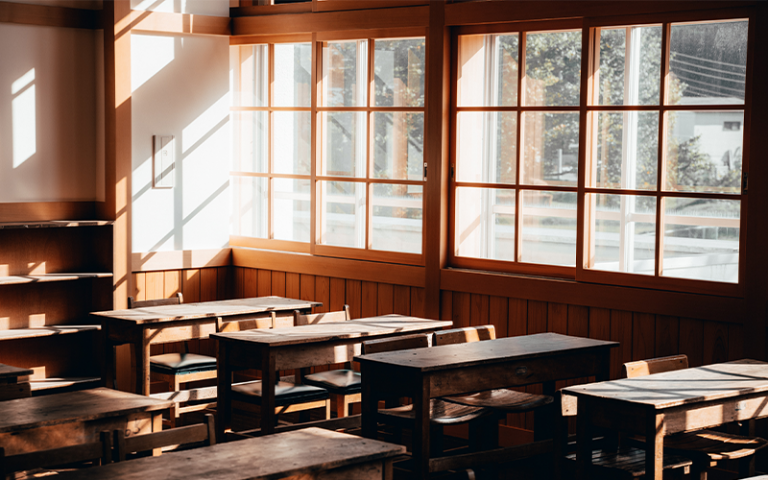The importance of daylighting in classrooms and its effect on primary students’ academic performance
10 March 2022
Environmental Design and Engineering MSc student (2020-21) Jean-Baptiste Clochet reviews the importance of daylighting in schools.

A classroom for primary school children should not only be designed for high academic performance, but also for the well-being of children. And what if some parameters, such as daylighting could both have a positive impact on student’s academic performance as well as their wellbeing? Indeed, primary school students spend 190 days per year at school and around 5-6 hours a day in classrooms in the UK [1], and their environment can have a decisive impact on their academic performance [2].
As schools are being renovated or newly built in the UK, government guidelines [3] state that for lighting to be suitable, attention needs to be paid to achieving the required lighting levels while giving priority to daylight. Controllers such as curtains or shutters to avoid excessive illuminance or glare should be provided while providing views to the outside.
Out of all design parameters in school, including air temperature, acoustics, and CO2 concentration, according to one study daylight has the highest impact on overall student progress [2]. Natural light positively contributes to a higher academic performance in reading as well as in science [4]. It also supports attention, the stability of the circadian cycle and overall health, mental health and comfort5, which in turn, leads to better academic performance.
In terms of design, it is fundamental to consider building orientation and sun path geometry. This is not only essential in terms of building performance to avoid overheating and glare, but also key in providing the best environmental conditions for students, especially for daylight. Easy to handle shutters and switches should be provided in the school facility for teachers, but also for students to modulate their learning environments. Light meters could also be provided to teachers instead of relying on teachers’ perceived lighting, which can be inaccurate [6]. The best lighting conditions in classrooms are those where teachers have diverse types of lighting controls, including shutters, curtains and dimming lights.
In addition to lighting controls, the complementarity of natural and artificial lighting is recommended [4], specifically with a lighting level of 400lux [6]. Recent studies advise the use of 6500K yellow lights [7] or 17000K blue-enriched LED lights [8] but further research is needed. Interestingly, productivity gains of $400,000 to $500,000 per year were made in less than a year after the building renovation and lighting changes of the Reno Post Office [9]. The renovation led to increased workers' attention and decreased headaches (which can be caused by non-adequate lighting conditions). Similarly, school retrofits could allow not only to reduce operational costs, but also to improve student academic performance and overall wellbeing.
Jean-Baptiste Clochet is a multi-curriculum graduate in architecture, structural and environmental engineering. Being passionate about the built and natural environments, he looks for creative and holistic solutions to face climate change and provide quality spaces. He is a 2020-2021 alumni from MSc Environmental Design and Engineering.
References
- Internations.org [Internet]. A Comprehensive Guide About the Education System and International Schools [accessed 2020 Dec 18]. Available from: https://www.internations.org/go/moving-to-the-uk/education.
- Barrett P, Davies F, Zhang Y, Barrett L. The impact of classroom design on pupils’ learning: Results of a holistic multi-level analysis. Build Environ. 2015;89(May):118–33.
- Department for Education. Advice on Standards for School Premises. 2013. Available from: https://assets.publishing.service.gov.uk/government/uploads/system/uploa...
- Heschong L, Wright RL, Okura S. Daylighting Impacts on Human Performance in School. J Illum Eng Soc. 2002 Jul 1;31(2):101–14.
- Sleegers PJC, Moolenaar NM, Galetzka M, Pruyn A, Sarroukh BE, Van Der Zande B. Lighting affects students’ concentration positively: Findings from three Dutch studies. Light Res Technol. 2013;45(2):159–75.
- Winterbottom M, Wilkins A. Lighting and discomfort in the classroom. J Environ Psychol. 2009;29(1):63–75.
- Choi K, Suk H-J. Dynamic lighting system for the learning environment: performance of elementary students. Opt Express. 2016;24(10):A907.
- Viola AU, James LM, Schlangen LJM, Dijk DJ. Blue-enriched white light in the workplace improves self-reported alertness, performance and sleep quality. Scand J Work Environ Heal. 2008;34(4):297–306.
- Edwards L, Torcellini P. A Literature Review of the Effects of Natural Light on Building Occupants A Literature Review of the Effects of Natural Light on Building Occupants. Technical Report National Renewable Energy Laboratory. 2002;(July):55.
Are you interested in studying Environmental Design and Engineering at UCL?

 Close
Close

